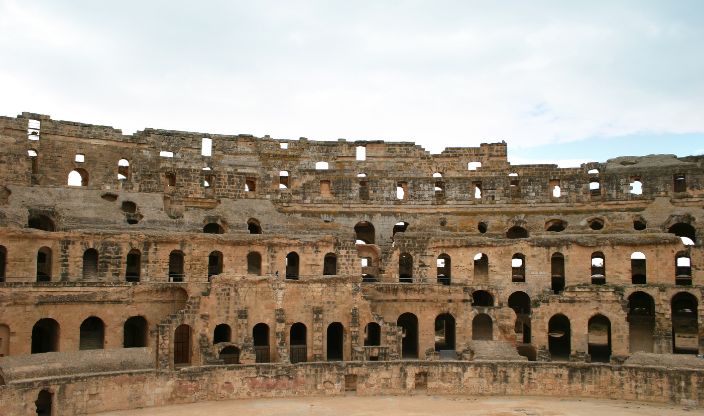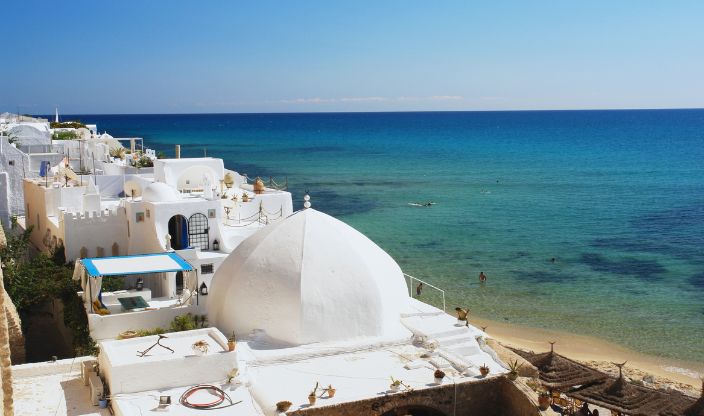Introducing Tunisia
Tunisia may be small compared to other North African nations, but it has a lot to offer. Although this popular vacation spot has the same chic hotels and warm beaches as many other places, it also combines a Mediterranean temperature with a desert environment and Berber traditions.
The area is full of historic sites. You may stroll through charming medinas in the capital, Tunis, and tourist areas like Sousse and Hammamet, where vendors sell Aladdin lamps in historically significant souks, whilst ancient kasbahs provide captivating ocean vistas. Some of the finest Tunisian food can be found in these traditional neighbourhoods, which are home to a mix of street food vendors and cafés that reflect bygone eras.
Exploring the Sahara Desert is an absolute must in this region, which is also the home of Lawrence of Arabia. There are several ways to explore the sand dunes, including camel rides, thrilling quad biking rides, and overnight stays with a traditional Berber tribe. And if after all this adventure you just want to relax on a beach, Tunisia dazzles with its selection of impressive soft sand beaches and endless sea views.
Tunisia is a Mediterranean Sea country that borders both Algeria and Libya. Italy and the country are separated by water on both sides.
Along with Algeria, Morocco, and Libya, Tunisia is a member of the Maghreb region of countries. It is the smallest of these nations. Tunisia is roughly twice the size of Austria and somewhat larger than the US state of Georgia. It is also slightly smaller than Suriname.
The Mediterranean environment in the coastal areas makes them productive. The country’s parched central plains, where water is in short supply, are connected to the Atlas Mountains in the north.
Tunisia experiences warm winters and hot, dry summers typical of the Mediterranean area.
The ideal time to travel to Tunisia if you’re looking for sun is between June and September.
With an average daily high temperature of 33 C and an average low temperature of 21 C, July is the hottest month of the year.
With an average daily high temperature of 16 C and an average low temperature of 6 C, January is the coolest month of the year.
The driest month is July, which has 31 ideal sunny days and 0 mm of precipitation. October is the wettest month, with 23 mm of rain falling over 2 days.
The best way to characterise Tunisian cuisine is as a fusion of traditional Punic-Berber cuisine with Mediterranean cuisine. Tunisian cuisine is largely based on seafood, meat, olive oil, tomatoes, and a variety of spices such cumin, caraway, coriander, and paprika, like many cultures in the Mediterranean.
Although Tunisian food is very similar to that of its neighbours in North Africa, it is considerably spicier. This is partly because Tunisian cuisine makes extensive use of harissa. The term “harissa” describes a hot paste prepared from a combination of ground garlic, chilli peppers, and spices. In many sauces, it plays the most crucial role and is the most widely used seasoning in Tunisian cooking. Some of the most notable dishes in Tunisian cuisine are couscous, rolled durum wheat cooked and served with either meat or vegetables; brik (borek in Turkish) a type of filo pastry filled sometimes filled with tuna, potato or shrimp and chakchuka, which is a typical breakfast dish of poached eggs served in a spicy tomato sauce with green peppers, onion, garlic, olive oil, paprika, harissa, cumin, and cayenne pepper.
The Phoenicians were the first to arrive; they settled in Carthage, utilised it as a commerce hub, and eventually engaged Rome in a lost war. Christianity also spread to Tunisia during the reign of the Romans, who ruled the region for several centuries. Following the fall of the Roman Empire, the Vandals attacked from the west, and the Byzantines then retook control from the east. In the seventh century, Muslim Arabs from the east overtook the Byzantines. Ever since, Tunisia has been primarily Muslim and Arabic-speaking, though rulers have risen and fallen. Tunisia was absorbed into the Ottoman Empire after 1574. Prior to the Ottomans, the Spanish temporarily controlled sections of Tunisia, and the French colonised the country from 1881 to 1956. In 1957 it was declared a Republic.
For miles of spotless beaches, a charming medina, and a wide selection of family-friendly hotels and resorts, travel to Hammamet. There are numerous bars and restaurants in the town.
Explore Port El Kantaoui, for opulent hotels and the country’s answer to the elegant marinas of the south of France, or stay in Sousse for a more authentic experience, where you can peruse the markets and wonder the narrow streets of the ancient medina.
Visit Tunis to explore the medina’s palaces and mosques, as well as the Bardo National Museum’s exhibits on ancient artefacts. Under a few of the contemporary city’s suburbs are the remains of the ancient city of Carthage. Carthage, which was once known as Tunis, was conquered by the Romans in 146 BC. Another great place to experience with the children is one of the biggest amphitheatres in the world. El Djem Amphitheatre was constructed while Tunisia was a part of the Roman Empire. It could accommodate more than 30 000 spectators. Between the cities of Sousse and Sfax is where you may find this well-known Tunisian monument.
Recommended Tunisia Specialists
Top Locations in Tunisia





